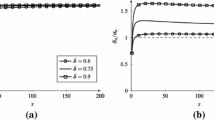Abstract
Modeling the long-tailedness property of network traffic with phase-type distributions is a powerful means to facilitate the consequent performance evaluation and queuing based analysis. This paper improves the recently proposed Fixed Hyper-Erlang model (FHE) by introducing an adaptive framework (Adaptive Hyper-Erlang model, AHE) to determine the crucially performance-sensitive model parameters. The adaptive model fits long-tailed traffic data set directly with a mixed Erlang distribution in a new divide-and-conquer manner. Compared with the well-known hyperexponential based models and the Fixed Hyper-Erlang model, the Adaptive Hyper-Erlang model is more flexible and practicable in addition to its accuracy in fitting the tail behavior.
Similar content being viewed by others
References
Gomes CP, Selman B, Kautz H (2000) Heavy-tailed phenomena in satisfiability and constraint satisfaction problems. J Autom Reas 24(1–2):67–100
Hernández-Campos F, Marron JS, Samorodnitsky G et al. (2004) Variable heavy tails in Internet traffic. Perform Eval 58:261–284
Casanova H (2005) Network modeling issues for grid application scheduling. Int J Found Comput Sci 16(2):145–162
Feitelson DG (2000) Sensitivity of parallel job scheduling to fat-tailed distributions. Technical Report 2000-44, The Hebrew University of Jerusalem, October 2000
Kleban SD, Clearwater SH (2003) Hierarchical dynamics, interarrival times, and performance. In: Proceedings of the 15th ACM/IEEE conference on high performance networking and computing (SC 2003), Phoenix, AZ, USA, November 2003
Ata S, Murata M, Miyahara H (2000) Analysis of network traffic and its application to design of high-speed routers. IEICE Trans Inf Syst E83-D(5):988–995
Starobinski D, Sidi M (2000) Modeling and analysis of power-tail distributions via classical teletraffic methods. Queuing Syst 36(1–3):243–267
Asaka T, Ori K, Yamamoto H (2003) Method of estimating flow duration distribution using active measurements. IEICE Trans Commun E86-B(10):3030–3037
Downey AB (2001) Evidence for long-tailed distributions in the Internet. In: Proceedings of ACM SIGCOMM Internet measurement workshop (IMW 2001), San Diego, CA, USA, November 2001
Bobbio A, Cumani A (1992) ML estimation of the parameters of a PH distribution in triangular canonical form. Perform Eval, 33–46
Feldmann A, Whitt W (1998) Fitting mixtures of exponentials to long-tailed distributions to analyze network performance models. Perform Eval 31(3–4):245–279
Wang J, Zhou H, Li L et al. (2006) A general model for long-tailed network traffic approximation. Springer J Supercomput 38(2):155–172
El Abdouni Khayari REA, Sadre R, Haverkort BR (2003) Fitting world-wide web request traces with the EM-algorithm. Perform Eval 52(2–3):175–191
Bilmes JA (1998) A gentle tutorial of the em algorithm and its application to parameter estimation for Gaussian mixture and hidden Markov models. Technical Report, TR-97-021, International Computer Science Institute, Berkeley, CA
Horvath A, Telek M (2000) Approximating heavy tailed behavior with phase type distribution. Adv Algorithmic Methods Stoch Models, 191–214
Riska A, Diev V, Smirni E (2004) An EM-based technique for approximating long-tailed data sets with PH distributions. Perform Eval 55(1):147–164
Fang Y, Chlamtac I (1999) Teletraffic analysis and mobility modeling of PCS networks. IEEE Trans Commun 47(7):1062–1073
Kelly F (2006) Reversibility and stochastic networks. New York, Wiley. http://www.statslab.cam.ac.uk/frank/rsn.html
Figueiredo MAT, Leitão JMN, Jain AK (1999) On fitting mixture models. In: Proceedings of the second international workshop on energy minimization methods in computer vision and pattern recognition (EMMCVPR 1999). Lecture notes in computer science. Springer, Berlin, pp 54–69
Fraley C, Raftery A (1998) How many clusters? Which clustering method? Answers via model-based cluster analysis. Technical Report 329, Department of Statistics, University of Washington, Seattle, WA
Whindham M, Cutler A (1992) Information ratios for validating mixture analysis. J Am Stat Assoc 87:1188–1192
Rissanen J (1989) Stochastic complexity in statistical inquiry. World Scientific, Singapore
Jain A, Moreau J (1988) Algorithms for clustering data. Prentice Hall, Englewood Cliffs
Wang J, Zhou M, Zhou H (2004) Clock synchronization for Internet measurements: a clustering algorithm. Comput Netw 45:731–741
NASA HTTP traces (2007) http://ita.ee.lbl.gov/html/contrib/NASA-HTTP.html
Wireless traces (2007) http://crawdad.cs.dartmouth.edu/data/tang/final.anon.tar.gz
Author information
Authors and Affiliations
Corresponding author
Rights and permissions
About this article
Cite this article
Wang, J., Liu, J. & She, C. Segment-based adaptive hyper-Erlang model for long-tailed network traffic approximation. J Supercomput 45, 296–312 (2008). https://doi.org/10.1007/s11227-008-0173-5
Received:
Accepted:
Published:
Issue Date:
DOI: https://doi.org/10.1007/s11227-008-0173-5




